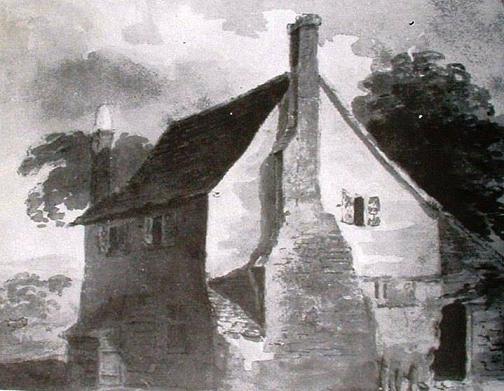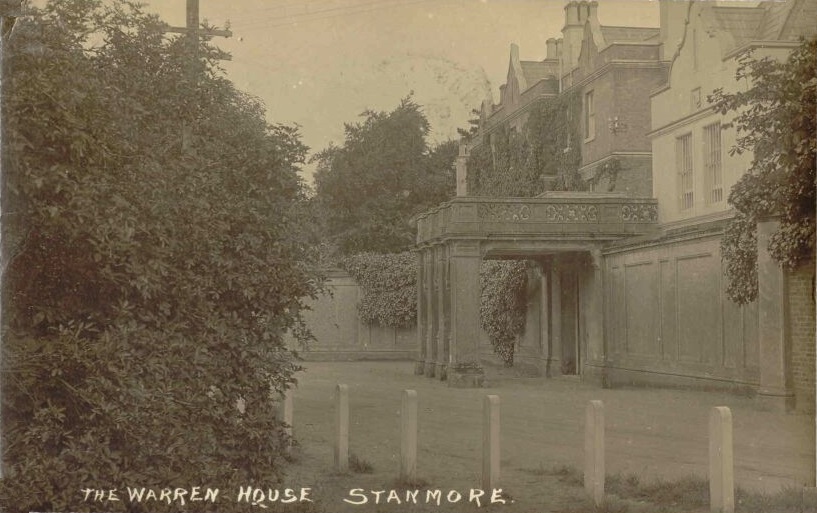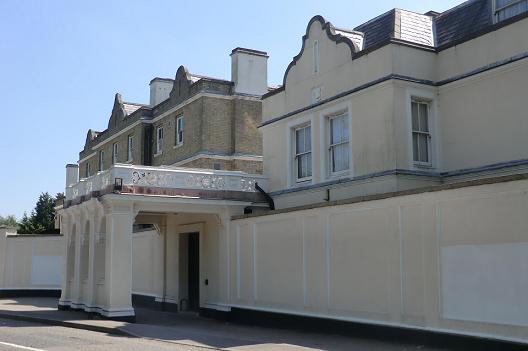Warren House, Wood Lane Stanmore With porte cochere.
Not far from the top of Stanmore Hill is Wood Lane. This is home to amongst other things Stanmore Hall, Spring Ponds and Warren House. Its hard to imagine that this impressive building once started life as a small Warreners Cottage on the old Stanmore pig farm.
It is thought that Warren House and its Estate grounds are situated within the ancient Roman city of Sulloniacae.
The recent history of Warren House dates back over 200 years. The land owner at the time Henry James Brydges - Earl of Carnarvon and first Duke of Chandos, had had it built he also owned the Dower house and Bowling Green house. The main entrance to the house was from Stanmore hill.
Warren house was originally a small scale cottage for the warrener, an obsolete term today meaning a person employed to supply rabbits for the Lord of the Manor, to take care of game and wildlife and also a general bailiff. In 1714 the rabbit warren of Stanmore Common covered some 44 acres. Much later in the 18th century however The warren developed into a large rambling house. In time the Manor house was sold off by trustees of the Brydges family to pay off the debts of a contemporary Duke's son. In 1780 James Forbes of the East India Company, purchased part of the estate of the second duke of Chandos which included Warren house Dower house and Cloisters wood, and had adorned the grounds of Dower House with the first pieces of Hindu sculpture to be seen in England.

After Forbes death in 1815 the house went through several hands and by 1827 the house was was in ownership of Sir Robert Smirke, later to be the architect of the British museum, kings collage and the Royal Mint who altered the house considerably in the Jacobean style including the addition of the porte cochere (a coach gate or carriage porch)
A plan accompanying the sale in 1842 shows pleasure gardens with a lake and Mr Forbes octagonal temple and in between the stable yard and house was a kitchen garden.
From 1851 to 1890 it was owned by Charles Keyser, founder and owner of the Colne Valley Water Company, which brought fresh water supplies to Stanmore for the first time. Keyser was instrumental in purifying drinking water therefore eradicating typhoid, epidemics of which swept London in the 1860's.

On Sunday 2nd June 1907 the 'Observer' of the day reported the private visit of King Edward VII to Warren House, to visit his friends. His Royal highness was expected for lunch but did not arrive until late afternoon, because his car broke down on two occasions. Still in high spirits, the King stayed for dinner and did not leave until the clock struck the midnight hour.
It later belonged to the financier Henry Louis Bishoffsheim(1829 - 1908), a city banker and hospital benefactor, of the firm Bishoffsheim & Goldschmidt. Later it was occupied by Sir John Gerald Maurice Fitzgerald (1884 - 1957), grandson of Henry Louis Bishoffsheim who moved in around 1925 after the death of his grandmother. Following the death of his mother Amelia Bishoffsheim in 1947 he sold the house in 1951 to the "National Coporation for the care of Old People". It was then transferred in 1964 to the Hendon group.
It changed hands again in 1951 and was bought by the ‘National Corporation for the care of old people’, the name of the property changed too, to become Springbok House, a hospital and old people's home financed from the 'South Africa gift to Britain fund'. Subsequently it became a Jewish Educational Centre. In 1984 the house was purchased to establish a religious centre.
